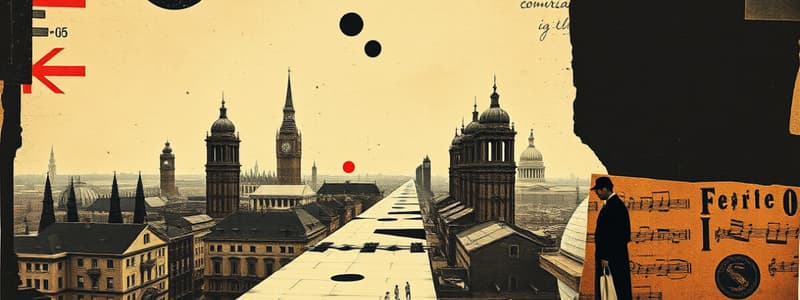Podcast
Questions and Answers
What term describes the characteristic of surfaces in visual art?
What term describes the characteristic of surfaces in visual art?
- Texture (correct)
- Intensity
- Form
- Volume
Which type of perspective represents distance through converging lines?
Which type of perspective represents distance through converging lines?
- Shallow Perspective
- Aerial Perspective
- Foreshortening
- Linear Perspective (correct)
In visual art, what does 'negative space' refer to?
In visual art, what does 'negative space' refer to?
- The amount of light in the artwork
- The overall design of the art piece
- The empty spaces around the subject (correct)
- The main subject of the artwork
What does the term 'volume' imply in visual art?
What does the term 'volume' imply in visual art?
In the context of art, which of the following is concerned with the overall design of a work?
In the context of art, which of the following is concerned with the overall design of a work?
What is the primary role of rhythm in music?
What is the primary role of rhythm in music?
Which type of balance in art features elements distributed around a central point?
Which type of balance in art features elements distributed around a central point?
Which term describes the relationship in sound that can be either harsh or smooth?
Which term describes the relationship in sound that can be either harsh or smooth?
What does the principle of emphasis in art achieve?
What does the principle of emphasis in art achieve?
Which type of texture in music involves one main melody accompanied by chords?
Which type of texture in music involves one main melody accompanied by chords?
Flashcards
Tempo
Tempo
The speed of the music, determining how fast or slow it feels.
Harmony
Harmony
Combines different musical pitches played simultaneously, creating a sense of harmony or dissonance.
Balance
Balance
The visual distribution of elements in an artwork, creating balance or imbalance.
Emphasis
Emphasis
Signup and view all the flashcards
Intensity
Intensity
Signup and view all the flashcards
Form
Form
Signup and view all the flashcards
Volume
Volume
Signup and view all the flashcards
Linear Perspective
Linear Perspective
Signup and view all the flashcards
Foreshortening
Foreshortening
Signup and view all the flashcards
Aerial Perspective
Aerial Perspective
Signup and view all the flashcards
Study Notes
Elements of Auditory Art
- Rhythm: Time-related element; establishes the pulse of the music.
- Beat: Basic unit of music; a foundational pattern.
- Tempo: Speed of the music, affecting its overall feel.
- Melody: Linear sequence of pitches, presented horizontally.
- Pitch: The highness or lowness of a musical sound.
- Harmony: Vertical combination of pitches; includes:
- Dissonance: Harsh-sounding combinations.
- Consonance: Smooth-sounding combinations.
- Timbre: Distinctive quality that differentiates one voice or instrument from another.
- Texture: Relates to the number and type of melodies in a composition:
- Monophonic: Single melodic line.
- Polyphonic: Multiple melodic lines.
- Homophonic: Main melody with accompanying chords.
Principles of Art
- Balance: Distribution of visual elements in relation to one another.
- Symmetrical: Elements mirrored across an axis.
- Asymmetrical: Uneven distribution; one side carries more weight.
- Radial: Elements arranged around a central point.
- Emphasis: Draws viewer's focus to a specific element or object.
- Contrast: Highlights differences between elements, enhancing the composition.
- Scale: Size of objects in relation to what is normal.
- Proportion: Measurement of the size of components relative to each other.
Color Concepts
- Light and Dark: Determined by values; includes:
- Tint: Lightened color value.
- Shade: Darkened color value.
- Intensity: Brightness or dullness of a color, varying from full intensity to neutral.
- Texture: Refers to the surface characteristics, such as roughness or smoothness.
Perspective in Visual Art
- Space: Areas around and between components; includes:
- Positive Space: The subject itself.
- Negative Space: Empty spaces around the subject.
- Open vs. Close Space: Emphasizes variations in area and occupation.
- Linear Perspective: Depth represented through converging lines.
- Foreshortening: Objects appear smaller based on observer's viewpoint.
- Aerial Perspective: Objects distant appear fainter due to atmospheric effects.
Forms and Volume
- Form: Overall design and shape of an artwork.
- Volume: Space occupied by an object in three dimensions; concerns solidity.
Visual Art Elements
- Lines: Represent figures and forms with direction; types include:
- Horizontal: Calm and serene.
- Vertical: Dynamic and poised.
- Diagonal: Suggest motion and action.
- Curved: Indicate grace and flexibility.
Lesson Objectives
- Identify elements of visual and auditory art.
- Differentiate principles of art.
- Explain the relevance of art elements and principles in artwork.
- Illustrate examples of hybrid art and analyze combined art forms.
Hybrid or Combined Art
- Exploration of artworks combining multiple art forms to create unique expressions.
Studying That Suits You
Use AI to generate personalized quizzes and flashcards to suit your learning preferences.




